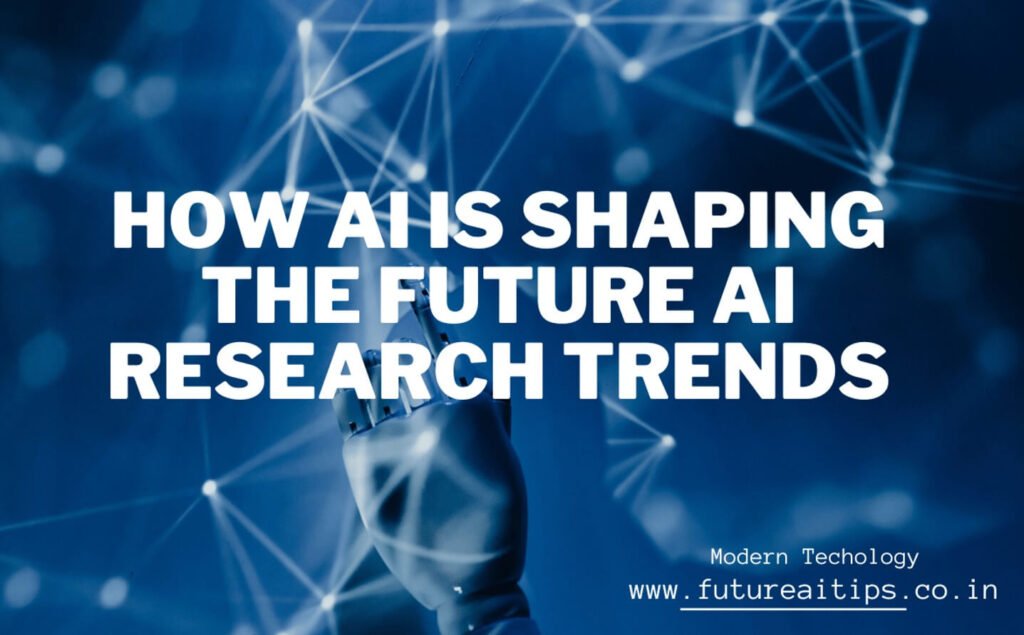Artificial intelligence and the future of India. How AI is Shaping the Future. AI Research Trends

AI research and its practical applications are not the same across various fields, which we refer to as “domains.” Each domain has its unique technologies, challenges, and impacts on different aspects of society and the economy. In this section, we will describe the current states of AI research and implementation, along with their effects and specific challenges, in eight different areas: transportation, home and service robotics, healthcare, education, underserved communities, public safety and security, employment and the workplace, and entertainment. We will also make predictions about future trends in a typical Indian city over the next fifteen years. Our aim is to provide a balanced overview of how AI is already starting to change everyday life and how these changes are likely to continue until 2030 in the Indian context.
AI Research Trends AI by Domain
Transportation
Transportation is one area where people in India will need to trust AI systems for important tasks soon. Self-driving vehicles will become common, and they’ll be the first time many people interact with AI in the real world. This will shape how people think about AI. When these self-driving cars become safe and reliable, they might suddenly become a big part of daily life, surprising people who will need time to get used to them. Since these cars will be better drivers than humans, people in cities might own fewer cars, live farther from work, and use their time differently. This will change how cities are organized. Artificial intelligence and the future of India
In the Indian city of 2030, it won’t just be cars and trucks that change. There might be flying vehicles and personal robots too, and these changes will bring up important social, ethical, and policy questions. Artificial intelligence and the future of India
Some of the trending research’s topics are :
Smarter Cars
Self-driving Vehicles
Transportation Planning
On-demand Transportation
Robots for Home service
Robots have made their way into people’s homes in the past fifteen years. It’s interesting to note that while we’ve seen improvements in the intelligence of these robots, the variety of tasks they can perform has not expanded as quickly. These advancements in AI often come from innovations in mechanical engineering, which in turn lead to the development of new AI techniques. The Future of AI Artificial intelligence and the future of India
Looking ahead to the next fifteen years in an Indian context, we can expect further progress in both mechanical and AI technologies, making home robots safer and more useful. These specialized robots will be able to deliver packages, clean offices, and enhance security. However, there will still be limitations due to the technical challenges and high costs associated with building reliable mechanical devices. Therefore, we will likely see robots used in specific, well-defined tasks rather than having a wide range of applications. Similar to self-driving cars and other new transportation technologies, creating dependable and market-ready hardware will remain a significant challenge. Artificial intelligence and the future of India
Healthcare

In the realm of AI technologies, healthcare has always held great promise. AI applications have the potential to enhance the well-being and healthcare quality for many individuals in the future. However, this will only happen if healthcare professionals, such as doctors and nurses, as well as patients, trust these AI systems, and if we address the various policy, regulatory, and commercial challenges. The Future of AI
Some important uses of AI in healthcare include assisting doctors in making clinical decisions, monitoring and providing guidance to patients, creating automated devices for surgery and patient care, and managing healthcare systems efficiently. Recent achievements, like using social media data to identify potential health risks, using machine learning to predict patient vulnerabilities, and employing robots in surgical procedures, have expanded our optimism about AI’s role in healthcare. Nevertheless, improving the ways AI interacts with medical professionals and patients will be a significant challenge.
Just like in other fields, data plays a crucial role here. There has been significant progress in gathering useful data from personal monitoring devices, mobile apps, electronic health records (EHRs) in clinical settings, and to some extent, medical robots aiding in procedures and hospital operations. However, using this data effectively for precise diagnostics and treatments for both individual patients and larger populations has proven to be complex. Outdated regulations and incentive systems have slowed down research and implementation. Additionally, challenges arise from ineffective human-computer interaction methods and the inherent complexities and risks of introducing technology into a vast and intricate healthcare system. Artificial intelligence and the future of India The Future of AI
Removing or reducing these obstacles, alongside forthcoming innovations, holds the potential to greatly enhance health outcomes and the quality of life for millions of people in India in the years to come. Artificial intelligence and the future of India
Some of the trending research’s topics are :
The Clinical Setting
Healthcare Analytics
Healthcare Robotics
Mobile Health
Elder Care
Education

In the past fifteen years, there have been significant advancements in AI within the field of education, and these applications are now widely used by educators and learners. However, the extent of their use varies between K-12 schools and universities. While it’s important to recognize that effective education always involves active participation from human teachers, AI holds the promise of improving education at all levels, especially by offering personalized learning experiences on a larger scale. Like in healthcare, the challenge lies in finding the best way to blend human interaction and in-person teaching with the potential of AI technologies.
Robots have been used in education for a long time, dating back to the early Lego Mindstorms kits created in collaboration with the MIT Media Lab in the 1980s. Intelligent Tutoring Systems (ITS) have been developed for subjects like science, math, and language, matching students with interactive machine tutors. The combination of Natural Language Processing, machine learning, and crowdsourcing has significantly enhanced online learning, enabling educators to reach more students while addressing their individual learning needs and preferences. The data collected from large online learning systems has driven the rapid growth of learning analytics.
However, schools and universities in India have been slow to adopt AI technologies due to financial constraints and a lack of solid evidence demonstrating their effectiveness in helping students achieve their educational goals. Looking ahead to the next fifteen years in India, the use of intelligent tutoring systems and other AI tools to support teachers in both classrooms and homes is likely to grow substantially. Additionally, learning through virtual reality applications is expected to expand. Nevertheless, computer-based learning systems are unlikely to completely replace human teachers in educational institutions.
Some of the trending research’s topics are :
Teaching Robots
Intelligent Tutoring Systems and Online Learning
Learning Analytics
Challenges and Opportunities
Broader Societal Consequences
Public Safety
Cities in India have already started using AI technologies for public safety and security, and by 2030, they are likely to rely on them extensively. These technologies include surveillance cameras capable of detecting unusual activities that might indicate a potential crime, drones for monitoring, and predictive policing tools. Like in many areas, there are both advantages and risks associated with these technologies, and gaining the trust of the public is crucial. While there are valid concerns that AI-based policing could become too invasive or widespread, there’s also the possibility that it can make policing more targeted and responsive. With careful implementation, AI might help reduce the biases inherent in human decision-making. Artificial intelligence and the future of India
One area where AI analytics have been successful is in identifying white-collar crimes like credit card fraud. The concern for cybersecurity, including dealing with spam, is widespread, and machine learning is playing a role in addressing these challenges. AI tools could also assist law enforcement in managing crime scenes or search and rescue missions by helping prioritize tasks and allocate resources, although full automation of such activities is not yet feasible. Advances in machine learning, particularly transfer learning, which speeds up learning by drawing from past experiences, could facilitate the development of such systems.
AI techniques can also be used to create intelligent simulations for training law enforcement personnel to collaborate effectively. Despite international criminal organizations and cross-border terrorism threats, police forces from different countries face challenges in coordinating their efforts. Training international groups of law enforcement personnel to work together is difficult but essential. Initiatives like LawTrain, supported by the European Union’s Horizon 2020 program, aim to facilitate such collaborations by moving from simulations to real investigations. Artificial intelligence and the future of India The Future of AI
Various security agencies in India, such as the Transportation Security Administration (TSA) and the Coast Guard, are likely to increase their reliance on AI to improve efficiency and effectiveness. AI techniques like vision analysis, speech analysis, and gait analysis can assist interviewers, interrogators, and security personnel in detecting deception and criminal behavior. For instance, the TSA is working on a project called DARMS to enhance airport security by tailoring security measures based on an individual’s risk categorization and flight details. Developers of such technology should be vigilant to avoid introducing biases, such as relying on biased datasets, when implementing these systems.
Entertainment

With the tremendous growth of the internet in the last fifteen years, it’s hard to imagine our daily lives without it. AI plays a significant role in powering the internet, making user-generated content a valuable source of information and entertainment. Social networks like Facebook have become widespread, serving as personalized hubs for social interaction and entertainment. However, they can sometimes reduce face-to-face interaction. the future of artificial intelligence group discussion.
Apps like WhatsApp and Snapchat keep smartphone users constantly connected with friends, allowing them to share sources of entertainment and information effortlessly. In online communities like Second Life and role-playing games such as World of Warcraft, people create alternate lives in virtual worlds. Specialized devices like Amazon’s Kindle have transformed cherished pastimes. Books can now be accessed and stored digitally, making reading as convenient as flipping through a pocket-sized paperback. The Future of AI
Trusted platforms for sharing blogs, videos, photos, and discussions have emerged on the internet, thanks to AI-driven techniques in natural language processing, information retrieval, image processing, crowdsourcing, and machine learning. Algorithms like collaborative filtering recommend movies, songs, or articles based on user data and preferences. The Future of AI
Even traditional forms of entertainment have embraced AI. Professional sports employ intensive quantitative analysis, monitoring on-field signals using advanced sensors and cameras. AI is used to compose music, recognize soundtracks, and create stage performances. Platforms like WordsEye generate 3D scenes from written descriptions. AI aids historical research in the arts, including stylometry and analyzing paintings. Artificial intelligence and the future of India artificial intelligence and the future of humans
The surprising enthusiasm for AI-driven entertainment has raised concerns about reduced interpersonal interaction. Many people now spend hours engaging with screens, even children who may prefer digital play to outdoor activities with friends. AI is poised to make entertainment more interactive, personalized, and engaging. Research should focus on harnessing these attributes for the benefit of individuals and society. The Future of AI
Read More
- What is Deepfake AI | Is Deepfake legal in India

- How AI can helpful at Ram Mandir Ayodhya Safety on January 22, 2024

- How Infosys loses $1.5 billion AI contract from global customer

- What is RAG Model ? How does rag work ? Future of Technology

- What is LLM large language model | Important LLM’s in 2023

- What happens if you go on the dark web | Is dark web illegal in India 2023?











0 Comments